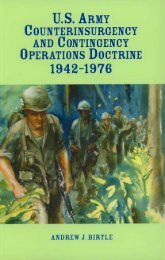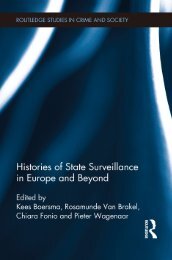C. Wiebes - Intelligence en de oorlog in Bosnië 1992-1995. De rol van de inlichtingen- en veiligheidsdiensten - Engels
C. Wiebes - Intelligence en de oorlog in Bosnië 1992-1995. De rol van de inlichtingen- en veiligheidsdiensten - Engels
C. Wiebes - Intelligence en de oorlog in Bosnië 1992-1995. De rol van de inlichtingen- en veiligheidsdiensten - Engels
- No tags were found...
Create successful ePaper yourself
Turn your PDF publications into a flip-book with our unique Google optimized e-Paper software.
17The second phase <strong>in</strong> the <strong>in</strong>tellig<strong>en</strong>ce cycle is the gather<strong>in</strong>g of raw data. 40 This can happ<strong>en</strong> <strong>in</strong> anumber of ways: firstly via op<strong>en</strong> sources, such as newspapers, magaz<strong>in</strong>es, books, governm<strong>en</strong>t studiesand radio and television broadcasts. This has also be<strong>en</strong> referred to for a number of years as Op<strong>en</strong>Source <strong>Intellig<strong>en</strong>ce</strong> (‘Os<strong>in</strong>t’). It is concerned with everyth<strong>in</strong>g that appears <strong>in</strong> pr<strong>in</strong>ted form or isbroadcast on radio or television. Thanks <strong>in</strong> part to the Internet, most services curr<strong>en</strong>tly draw a largeamount of their <strong>in</strong>formation from op<strong>en</strong> sources. It is estimated that (and it is only a guess) that un<strong>de</strong>ri<strong>de</strong>al circumstances, op<strong>en</strong> source <strong>in</strong>formation will comprise somewhere around 10%-15% of the<strong>in</strong>tellig<strong>en</strong>ce <strong>in</strong>put <strong>in</strong>to an all-source analysis. It is therefore <strong>in</strong>correct to equate <strong>in</strong>tellig<strong>en</strong>ce with‘espionage’, although this mistake is commonly ma<strong>de</strong>. Espionage actually refers exclusively to variousclan<strong>de</strong>st<strong>in</strong>e ways of gather<strong>in</strong>g <strong>in</strong>formation. An example of such a furtive method would be the use oftechnical resources like film, photography or electronic <strong>in</strong>tercept traffic, typically carried out fromstations on land, special ships, aircraft or satellites. We will later <strong>de</strong>al more ext<strong>en</strong>sively with these specialforms of <strong>in</strong>tellig<strong>en</strong>ce, which <strong>in</strong>clu<strong>de</strong> Signals <strong>Intellig<strong>en</strong>ce</strong> (‘sig<strong>in</strong>t’), Communications <strong>Intellig<strong>en</strong>ce</strong>(‘Com<strong>in</strong>t’), Radar <strong>Intellig<strong>en</strong>ce</strong> (‘Rad<strong>in</strong>t’) and Imagery <strong>Intellig<strong>en</strong>ce</strong> (‘Im<strong>in</strong>t’).A second method of gather<strong>in</strong>g <strong>in</strong>tellig<strong>en</strong>ce is from human sources, which is known as Human<strong>Intellig<strong>en</strong>ce</strong> (‘Hum<strong>in</strong>t’). Hum<strong>in</strong>t <strong>in</strong>volves <strong>in</strong>tellig<strong>en</strong>ce gather<strong>in</strong>g through person-to-person contacts,<strong>in</strong>clud<strong>in</strong>g through a party’s own ag<strong>en</strong>ts, reports from attachés, other diplomatic report<strong>in</strong>g and thesystematic <strong>de</strong>brief<strong>in</strong>g of Displaced Persons, emigrants, <strong>de</strong>serters, captured soldiers, released hostages,and so on. The clan<strong>de</strong>st<strong>in</strong>e part of Hum<strong>in</strong>t is concerned <strong>in</strong> g<strong>en</strong>eral with the use of case officers orag<strong>en</strong>ts, who furnish <strong>in</strong>formation that is unobta<strong>in</strong>able <strong>in</strong> any other way from op<strong>en</strong> sources. Here, case41officers are employees of national <strong>in</strong>tellig<strong>en</strong>ce services, and ag<strong>en</strong>ts are mostly of foreign orig<strong>in</strong>.Hum<strong>in</strong>t is particularly important <strong>in</strong> peacekeep<strong>in</strong>g operations. Both the local population and s<strong>en</strong>iorsoldiers or politicians may <strong>de</strong>liver valuable <strong>in</strong>tellig<strong>en</strong>ce. Displaced Persons from a Safe Area can oft<strong>en</strong>also come up with important <strong>in</strong>formation <strong>in</strong> systematic <strong>de</strong>brief<strong>in</strong>gs, as can the non-governm<strong>en</strong>talorganizations that operate <strong>in</strong> certa<strong>in</strong> areas.The third and most important step <strong>in</strong> the cycle is the process<strong>in</strong>g of all received data, from bothop<strong>en</strong> and secret sources. The large <strong>in</strong>tellig<strong>en</strong>ce services, for example, <strong>de</strong>al with <strong>en</strong>ormous quantities of<strong>in</strong>tercepted message traffic that has to be <strong>de</strong>co<strong>de</strong>d or translated. It is also necessary to process data <strong>in</strong>the first <strong>in</strong>stance us<strong>in</strong>g ad<strong>van</strong>ced computers. Moreover, photographs, films and other record<strong>in</strong>gs haveto be <strong>de</strong>veloped before they can be studied and <strong>in</strong>vestigated further. Furthermore, Hum<strong>in</strong>t reports haveto be analysed <strong>in</strong> more <strong>de</strong>tail and verified aga<strong>in</strong>st <strong>in</strong>tellig<strong>en</strong>ce obta<strong>in</strong>ed from Sig<strong>in</strong>t and Im<strong>in</strong>t. In abattalion, this is ma<strong>in</strong>ly done by a section known as S-2 and, at UNPROFOR level, G-2. The othersections are <strong>de</strong>alt with more compreh<strong>en</strong>sively <strong>in</strong> the ma<strong>in</strong> report, whereas this study focuses on the<strong>in</strong>tellig<strong>en</strong>ce activities usually <strong>de</strong>signated as such <strong>in</strong> military organizations.A low <strong>in</strong>t<strong>en</strong>sity conflict <strong>de</strong>mands that <strong>in</strong>tellig<strong>en</strong>ce is appraised differ<strong>en</strong>tly from <strong>in</strong>tellig<strong>en</strong>cegathered <strong>in</strong> a war situation, which is what army tra<strong>in</strong><strong>in</strong>g focuses on. In a normal war, for example, fourtanks on a road would be assessed <strong>in</strong> the traditional way as ‘re<strong>in</strong>forcem<strong>en</strong>t or reconnaissance’, whereas<strong>in</strong> Bosnia it oft<strong>en</strong> heral<strong>de</strong>d a large-scale off<strong>en</strong>sive.On receipt of data, the <strong>in</strong>tellig<strong>en</strong>ce would without doubt have be<strong>en</strong> analysed <strong>in</strong> further <strong>de</strong>tail atsector level (such as Sector North East of UNPROFOR, which <strong>in</strong>clu<strong>de</strong>d Srebr<strong>en</strong>ica). In thisconnection, the <strong>in</strong>formation provi<strong>de</strong>d by the United Nations Military Observers (UNMOs) would haveplayed an important <strong>rol</strong>e. This was a two-way process: <strong>in</strong>tellig<strong>en</strong>ce would have flowed from the higherechelons of Bosnia-Hercegov<strong>in</strong>a Command <strong>in</strong> Sarajevo (later known as UNPROFOR) and theUNPROFOR headquarters <strong>in</strong> Zagreb (later known as UNPF) to Sector North East and to Dutchbat,and vice versa.40 <strong>De</strong> Valk po<strong>in</strong>ts out that the Netherlands National Security Service (BVD) used the word ‘gather<strong>in</strong>g’ and not collect<strong>in</strong>g.<strong>De</strong> Valk, <strong>De</strong> BVD <strong>en</strong> Inlicht<strong>in</strong>g<strong>en</strong>rapportages, p. 25.41 Godson, May & Schmitt, U.S. <strong>Intellig<strong>en</strong>ce</strong> at the Crossroads, p. 4. There is also the third, somewhat vaguer, category known as‘grey sources’. These are people or companies who, <strong>in</strong>t<strong>en</strong>tionally or un<strong>in</strong>t<strong>en</strong>tionally, disclose s<strong>en</strong>sitive <strong>in</strong>formation <strong>in</strong> thecourse of conversations.





